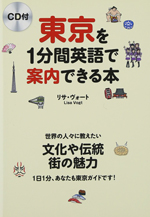 2020年に向けて、ますます増え続けるであろう外国人観光客。彼らを「おもてなし」するツール、それが英語です。
2020年に向けて、ますます増え続けるであろう外国人観光客。彼らを「おもてなし」するツール、それが英語です。
東京をガイドする英文を紹介する本書『東京を1分間英語で案内できる本』で、あなたも知的に、楽しく「英語で東京案内」してみませんか?
◇◇◇
前の記事「1分間英語でTokyo案内「お寺と神社はどう区別すればいいの?」(19)」はこちら。
東京の神社
Shintoist shrines
Shintoism has no founder and scripture, and its followers believe that all things in nature are inhabited by a kami, a deity.
When praying at a shrine, people usually bow twice, clap twice and bow again to show their respects and to give thanks and pray for good fortune. All shrines have a torii gate that marks the entrance to the shrine. Upon entering, you'll find a purification fountain and the main hall.
One of the oldest and grandest shrines in Tokyo is the Kanda Myojin, originally built more than a thousand years ago.
~覚えておきたい語句・表現~
founder ...... 創設者
scripture ...... 聖典
follower ...... 信奉者
inhabit ...... ~に住む
deity ...... 神性、神
bow ...... お辞儀する
clap ...... 手をたたく
show one's respect ...... 敬意を表する
purification ...... 浄化
fountain ...... 泉
【和訳】
神道には開祖も経典もなく、あらゆる自然に神が宿っているという考え方をします。
神社を参拝する際は、2 回お辞儀し、2回柏手を打ち、もう1回お辞儀をして敬意を示し、感謝と幸運を祈ります。すべての神社には、その神社の入口を示す鳥居があります。中に入ると、清めの水場と、本殿が目に入るでしょう。
東京で最も古く、立派な神社の1 つは、元々は1,000 年以上前に建てられた神田明神です。
★ワンポイント解説
神社には本尊となる像などはなく、神が一時的に宿るご神体があるだけです。柏手を打つ音は、目には見えないけれどもどこにでも遍在している神を呼び出すためのものなのだそうですね。
【会話で東京案内】
A:Is this a shrine or a temple?
ここは神社? それともお寺?
B:We went through a torii gate so that would make this a shrine.
鳥居をくぐったということは、ここは神社だよ。
A:All shrines have a torii ?
どの神社にも鳥居があるの?
B:That's right. Once in a while a temple does too, but it's rare.
そう。お寺にもあるけど、めったにないね。



